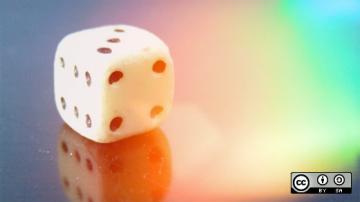There are a couple of ways to learn a programming language. If you're new to coding, you usually learn some basic computer coding concepts and try to apply them. If you already know how to code in another language, you relearn how coding concepts are expressed in the new language.
In either case, a convenient way to learn these new principles is to create a simple guessing game. This forces you to understand how a language receives input and sends output, how it compares data, how to control a program's flow, and how to leverage conditionals to affect an outcome. It also ensures that you know how a language structures its code; for instance, Lua or Bash can easily run as a script, while Java requires you to create a class.
In this article, I'll demonstrate how to implement a guessing game for the terminal in C++.
Install dependencies
To follow along with this article, you need C++ and a compiler.
You can get everything you need on Linux by installing the Qt Creator IDE from your distribution's software repository.
On Fedora, CentOS, or RHEL:
$ sudo dnf install qt-creatorOn Debian, Ubuntu, Chromebook, or similar:
$ sudo apt install qtcreatorThis article doesn't utilize the Qt Creator IDE, but it's an easy way to get everything you need installed, and for complex C++ projects (including those with a GUI), it's an essential tool to have. On macOS or Windows, follow the installation instructions on Qt's website.
Set up includes and namespace
C++'s core language is minimal. Even a simple application requires the use of additional libraries. This application uses iostream to gain access to the cout and cin keywords.
Also, ensure that the program uses the std namespace:
#include <iostream>
#include <stdlib.h> // srand
using namespace std;This isn't strictly necessary, but without setting the namespace to std, all keywords from the iostream library require a namespace prefix. For instance, instead of writing cout, I would have to write std::cout.
Statements in C++ terminate with a semicolon.
Create a function
Every C++ application requires at least one function. The primary function of a C++ application must be called main, and it must return an integer (int), which corresponds to the POSIX expectation that a process returns 0 upon success and something else upon failure. You create a new function by providing its return type and then its name:
int main() {
// code goes here
}Implement program logic
The game code must first produce a random number for the player to guess. You do this in C++ by establishing a seed for pseudo-random number generation. A simple seed is the current time. Once the seed starts, you retrieve a number between 1 and 100 by calling the rand function with an upper constraint of 100. This generates a random number from 0 to 99, so add 1 to whatever number is chosen and assign the result to a variable called number. You must also declare a variable to hold the player's guess. For clarity, I'm calling this variable guess.
This sample code also includes a debug statement that tells you exactly what the random number is. This isn't very good for a guessing game, but it makes testing a lot faster. Later, you can remove the line or just comment it out by prefacing it with //:
srand (time(NULL));
int number = rand() % 100+1;
int guess = 0;
cout << number << endl; //debugAdd do-while and if statements
A do-while statement in C++ starts with the keyword do and encloses everything that you want C++ to do in braces. Close the statement with the while keyword followed by the condition that must be met (in parentheses):
do {
// code here
} while ( number != guess );The game code occurs within an if statement with an else if and else statements to provide the player with hints.
First, prompt the player for a guess with a cout statement. The cout function prints output onto stdout. Because the cout statement isn't appended with the endl (endline) function, no linebreak occurs. Immediately following this cout statement, tell C++ to wait for input by using the cin function. As you might surmise, cin waits for input from stdin.
Next, the program enters the if control statement. If the player's guess is greater than the pseudo-random number contained in the number variable, then the program prints out a hint followed by a newline character. This breaks the if statement, but C++ is still trapped within the do-while loop because its condition (the number variable being equal to guess) has not yet been met.
If the player's guess is less than the pseudo-random number contained in the number variable, then the program prints out a hint followed by a newline character. This again breaks the if statement, but the program remains trapped within the do-while loop.
When guess is equal to number, the key condition is finally met, the else statement is triggered, the do-while loop ends, and the application ends:
do {
cout << "Guess a number between 1 and 100: ";
cin >> guess;
if ( guess > number) { cout << "Too high.\n" << endl; }
else if ( guess < number ) { cout << "Too low.\n" << endl; }
else {
cout << "That's right!\n" << endl;
exit(0);
} // fi
} while ( number != guess );
return 0;
} // mainBuilding the code and playing the game
You can build your application with GCC:
$ g++ -o guess.bin guess.cppRun the binary to try it out:
$ ./guess.bin
74
Guess a number between 1 and 100: 76
Too high.
Guess a number between 1 and 100: 1
Too low.
Guess a number between 1 and 100: 74
That's right!Success!
Give C++ a try
The C++ language is complex. Writing C++ applications for terminals can teach you a lot about data types, memory management, and code linking. Try writing a useful utility in C++ and see what you can discover!










Comments are closed.